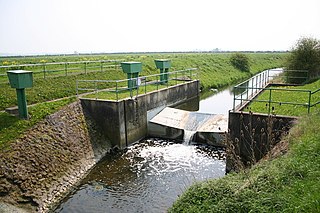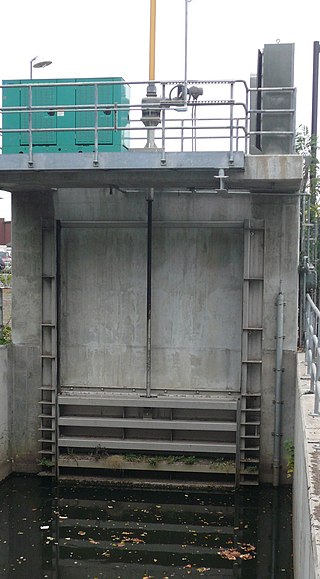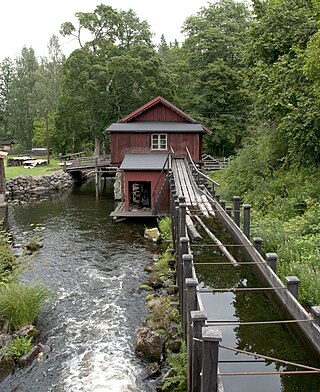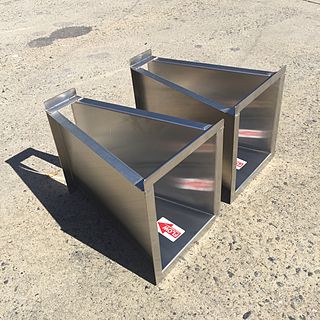In thermal fluid dynamics, the Nusselt number is the ratio of convective to conductive heat transfer at a boundary in a fluid. Convection includes both advection and diffusion (conduction). The conductive component is measured under the same conditions as the convective but for a hypothetically motionless fluid. It is a dimensionless number, closely related to the fluid's Rayleigh number.

A stream gauge, streamgage or stream gauging station is a location used by hydrologists or environmental scientists to monitor and test terrestrial bodies of water. Hydrometric measurements of water level surface elevation ("stage") and/or volumetric discharge (flow) are generally taken and observations of biota and water quality may also be made. The locations of gauging stations are often found on topographical maps. Some gauging stations are highly automated and may include telemetry capability transmitted to a central data logging facility.
Flow measurement is the quantification of bulk fluid movement. Flow can be measured in a variety of ways. The common types of flowmeters with industrial applications are listed below:

A weir or low head dam is a barrier across the width of a river that alters the flow characteristics of water and usually results in a change in the height of the river level. Weirs are also used to control the flow of water for outlets of lakes, ponds, and reservoirs. There are many weir designs, but commonly water flows freely over the top of the weir crest before cascading down to a lower level.

Sluice is a word for a channel controlled at its head by a movable gate which is called a sluice gate. A sluice gate is traditionally a wood or metal barrier sliding in grooves that are set in the sides of the waterway and can be considered as a bottom opening in a wall. Sluice gates are one of the most common hydraulic structures in controlling flow rate and water level in open channels such as rivers and canals. They also could be used to measure the flow. A water channel containing a sluice gate forms a type of lock to manage the water flow and water level. It can also be an open channel which processes material, such as a River Sluice used in gold prospecting or fossicking. A mill race, leet, flume, penstock or lade is a sluice channeling water toward a water mill. The terms sluice, sluice gate, knife gate, and slide gate are used interchangeably in the water and wastewater control industry. They are also used in wastewater treatment plants and to recover minerals in mining operations, and in watermills.

In physics and engineering, in particular fluid dynamics, the volumetric flow rate is the volume of fluid which passes per unit time; usually it is represented by the symbol Q. It contrasts with mass flow rate, which is the other main type of fluid flow rate. In most contexts a mention of rate of fluid flow is likely to refer to the volumetric rate. In hydrometry, the volumetric flow rate is known as discharge.
In hydrology, discharge is the volumetric flow rate of water that is transported through a given cross-sectional area. It includes any suspended solids, dissolved chemicals, or biologic material in addition to the water itself. Terms may vary between disciplines. For example, a fluvial hydrologist studying natural river systems may define discharge as streamflow, whereas an engineer operating a reservoir system may equate it with outflow, contrasted with inflow.

A flume is a human-made channel for water, in the form of an open declined gravity chute whose walls are raised above the surrounding terrain, in contrast to a trench or ditch. Flumes are not to be confused with aqueducts, which are built to transport water, rather than transporting materials using flowing water as a flume does. Flumes route water from a diversion dam or weir to a desired materiel collection location. Flumes are usually made up of wood, metal or concrete.
An orifice plate is a device used for measuring flow rate, for reducing pressure or for restricting flow.

Hydraulic head or piezometric head is a specific measurement of liquid pressure above a vertical datum.
The Manning formula or Manning's equation is an empirical formula estimating the average velocity of a liquid flowing in a conduit that does not completely enclose the liquid, i.e., open channel flow. However, this equation is also used for calculation of flow variables in case of flow in partially full conduits, as they also possess a free surface like that of open channel flow. All flow in so-called open channels is driven by gravity.
Drainage density is a quantity used to describe physical parameters of a drainage basin. First described by Robert E. Horton, drainage density is defined as the total length of channel in a drainage basin divided by the total area, represented by the following equation:
The river regime generally describes the character of the typical fluctuations of flow of a river, but can also refer to the mathematical relationship between the river discharge and its width, depth and slope. Thus, "river regime" can describe one of two characteristics of a reach of an alluvial river:

Stream power originally derived by R. A. Bagnold in the 1960s is the amount of energy the water in a river or stream is exerting on the sides and bottom of the river. Stream power is the result of multiplying the density of the water, the acceleration of the water due to gravity, the volume of water flowing through the river, and the slope of that water. There are many forms of the stream power formula with varying utilities such as comparing rivers of various widths or quantify the energy required to move sediment of a certain size. Stream power is closely related to various other criterion such as stream competency and shear stress. Stream power is a valuable measurement for hydrologists and geomorphologist tackling sediment transport issues as well as for civil engineers using it in the planning and construction of roads, bridges, dams, and culverts.
Flow conditioning ensures that the “real world” environment closely resembles the “laboratory” environment for proper performance of inferential flowmeters like orifice, turbine, coriolis, ultrasonic etc.

The Parshall flume is an open channel flow metering device that was developed to measure the flow of surface waters and irrigation flows. The Parshall flume is a fixed hydraulic structure. It is used to measure volumetric flow rate in industrial discharges, municipal sewer lines, and influent/effluent flows in wastewater treatment plants. The Parshall flume accelerates flow through a contraction of both the parallel sidewalls and a drop in the floor at the flume throat. Under free-flow conditions the depth of water at specified location upstream of the flume throat can be converted to a rate of flow. Some states specify the use of Parshall flumes, by law, for certain situations.

Open channel spillways are dam spillways that utilize the principles of open-channel flow to convey impounded water in order to prevent dam failure. They can function as principal spillways, emergency spillways, or both. They can be located on the dam itself or on a natural grade in the vicinity of the dam.

A Montana flume, is a popular modification of the standard Parshall flume. The Montana flume removes the throat and discharge sections of the Parshall flume, resulting a flume that is lighter in weight, shorter in length, and less costly to manufacture. Montana flumes are used to measure surface waters, irrigations flows, industrial discharges, and wastewater treatment plant flows.

The Palmer-Bowlus flume, is a class of flumes commonly used to measure the flow of wastewater in sewer pipes and conduits. The Palmer-Bowlus flume has a u-shaped cross-section and was designed to be inserted into, or in line with, pipes and u-channels found in sanitary sewer applications.
This article is about flow in partially full conduits.


















